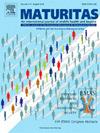No increased arterial stiffness after premenopausal risk-reducing salpingo-oophorectomy (RRSO)
IF 3.6
2区 医学
Q2 GERIATRICS & GERONTOLOGY
引用次数: 0
Abstract
Objective
Women at high familial risk of ovarian cancer are recommended to undergo premenopausal risk-reducing salpingo-oophorectomy (RRSO). The procedure leads to immediate surgical menopause, and while early natural menopause is associated with an increase in the risk of cardiovascular disease (CVD), evidence on CVD risk after surgical menopause is inconsistent.
Main outcome measures
To investigate the long-term CVD risk after surgical menopause we conducted a cross-sectional study comparing a group of women who underwent a premenopausal RRSO (≤45 years) with a group who underwent postmenopausal RRSO (≥54 years). We assessed arterial stiffness, measured by pulse wave velocity (PWV). Increased PWV has been shown to be an independent predictor for CVD. Age differences between the pre- and postmenopausal RRSO groups were accounted for by restricting analyses to women aged 60–70 at study visit (n = 307). Within the premenopausal RRSO group (n = 461), we also examined the effect of timing of premenopausal RRSO on PWV (RRSO<41 vs RRSO 41–45 years). In addition, we assessed the association between PWV and coronary artery calcium (CAC) in women who underwent premenopausal RRSO.
Results
In women aged 60–70 at study visit, PWV levels were significantly lower in the premenopausal RRSO group compared with the postmenopausal RRSO group (β: -0.87, 95 % CI, −1.45, −0.28 for PWV level; RR: 0.47, 95 % CI, 0.24, 0.93 for being in the upper PWV quintile). The timing of premenopausal RRSO did not influence PWV. Among all women who underwent premenopausal RRSO, having a PWV in the upper quintile was an independent predictor of the presence of CAC (RR 1.32, 95 % CI, 1.04–1.68 for CAC > 0).
Conclusion
Our study does not support a long-term adverse effect of premenopausal RRSO on arterial stiffness, but increased arterial stiffness is associated with the presence of CAC in women who have undergone a premenopausal RRSO.
Clinical trial registration
The pre-registered clinical trial number is <NCT03835793>.
绝经前风险降低性输卵管切除术(RRSO)后动脉僵硬度不会增加
目的:推荐具有高家族性卵巢癌风险的女性在绝经前进行降低风险的输卵管卵巢切除术(RRSO)。手术导致立即手术绝经,虽然早期自然绝经与心血管疾病(CVD)风险增加有关,但手术绝经后CVD风险的证据并不一致。为了调查手术绝经后的长期心血管疾病风险,我们进行了一项横断面研究,比较了绝经前(≤45岁)和绝经后(≥54岁)进行RRSO的妇女。我们通过脉搏波速度(PWV)评估动脉硬度。PWV升高已被证明是CVD的独立预测因子。绝经前和绝经后RRSO组之间的年龄差异是通过限制研究访问时60-70岁女性的分析来解释的(n = 307)。在绝经前RRSO组(n = 461)中,我们还研究了绝经前RRSO时间对PWV的影响(RRSO<;41 vs RRSO 41 - 45年)。此外,我们评估了PWV与绝经前RRSO妇女冠状动脉钙(CAC)之间的关系。结果60-70岁女性在研究访问时,绝经前RRSO组PWV水平显著低于绝经后RRSO组(β: -0.87, 95% CI, - 1.45, - 0.28);相对危险度(RR): 0.47, 95% CI, 0.24, 0.93 (PWV上五分位数)。绝经前RRSO的时间对PWV没有影响。在所有接受过绝经前RRSO的女性中,PWV在上五分位数是CAC存在的独立预测因子(RR 1.32, 95% CI, 1.04-1.68;结论:本研究不支持绝经前RRSO对动脉僵硬度的长期不良影响,但在绝经前RRSO的女性中,动脉僵硬度的增加与CAC的存在有关。临床试验注册预注册临床试验编号为NCT03835793>;
本文章由计算机程序翻译,如有差异,请以英文原文为准。
求助全文
约1分钟内获得全文
求助全文
来源期刊

Maturitas
医学-妇产科学
CiteScore
9.10
自引率
2.00%
发文量
142
审稿时长
40 days
期刊介绍:
Maturitas is an international multidisciplinary peer reviewed scientific journal of midlife health and beyond publishing original research, reviews, consensus statements and guidelines, and mini-reviews. The journal provides a forum for all aspects of postreproductive health in both genders ranging from basic science to health and social care.
Topic areas include:• Aging• Alternative and Complementary medicines• Arthritis and Bone Health• Cancer• Cardiovascular Health• Cognitive and Physical Functioning• Epidemiology, health and social care• Gynecology/ Reproductive Endocrinology• Nutrition/ Obesity Diabetes/ Metabolic Syndrome• Menopause, Ovarian Aging• Mental Health• Pharmacology• Sexuality• Quality of Life
 求助内容:
求助内容: 应助结果提醒方式:
应助结果提醒方式:


